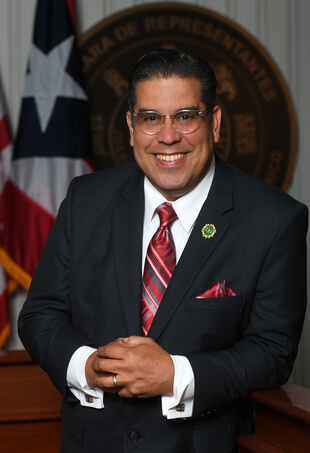2022-03
Promoting Food Equity and Nutritional Security in the United States, including extending SNAP to Puerto Rico
Sponsored by Rep. Juan Candelaria (CT), Rep. Rafael "Tatito" Hernández (PR), Asmb. Mia Bonta (CA), Rep. Victoria Neave (TX), and Rep. Carlos E. Tobón (RI)
Reported to the Caucus by the NHCSL Goverment, Social Justice and Taxation
Del. Alfonso López (VA), Chair
Unanimously approved by the NHCSL Executive Committee on behalf of the entire Caucus on August 12, 202
Nutrition insecurity has been an ongoing concern
WHEREAS, a healthy diet consisting of proper nutrients and adequate caloric intake can promote healthy childhood development, as well as help people achieve and maintain good health throughout their lives;[1] and,
WHEREAS, nutritionally inadequate dietary intake is a leading contributor to the development of chronic cardiometabolic diseases;[2] and,
WHEREAS, food insecurity, a common cause of inadequate nutrition, is defined by the U.S. Department of Agriculture (USDA) as a “household-level economic and social condition of limited or uncertain access to adequate food;”[3] and,
WHEREAS, food insecurity can quickly contribute to disparities in chronic disease outcomes, especially for cardiovascular diseases;[4] and,
WHEREAS, nutrition security refers to “an individual or household condition of having equitable and stable availability, access, affordability, and utilization of foods and beverages that promote well-being and prevent and treat disease;”[5] and,
WHEREAS, there is growing consensus that U.S. food policies and programs should continue to focus on “nutrition security” in addition to the broader scope of “food security;”[6] and,
WHEREAS, an essential part of nutrition security is access to culturally appropriate nutritional food that fits the needs of peoples across culinary and religious traditions;[7] and,
WHEREAS, the current model SNAP uses to calculate a household’s benefits assumes that every family will spend 30 percent of their net income on food,[8] leading to only families with absolutely no income to receive full SNAP benefits and the majority of SNAP participants to receive lesser assistance; and,
WHEREAS, this Caucus first addressed the issue of nutrition security for children in Resolution 2005-03, Healthy Child Initiative, calling for a multi-faceted approach, promoting and encouraging nutrition education, and funding to address childhood obesity; and,
WHEREAS, this Caucus renewed that call and also addressed the issue of food deserts, and lack of nutrition security beyond children, in Resolution 2007-06, On the 2007 Farm Bill, which called, among other things, for:
- Strengthening the food stamp and nutrition programs; increasing the minimum for food stamp benefits; revising asset limits; removing the residency cap for legal non-citizens; simplifying the application and renewal process of the food stamp program; and developing incentives to encourage food stamp recipients to increase their consumption of fruits and vegetables; and for,
- Promoting healthy diets for all Americans; incentivizing businesses and individuals, and the appropriation of resources toward more fruit/vegetable production, increased access to healthy and locally grown foods; expanding community-level investment in retail markets and food-based businesses; and a significant expansion of the USDA Department of Defense (DoD) Fresh program that brings seasonal fruits and vegetables into our schools; and,
WHEREAS, this Caucus renewed its call for addressing food deserts in Resolution 2010-01, To Support the Passage of H.R. 3100, the Food Desert Oasis Act of 2009 and Other Action to Address the Nation's Food Deserts; and,
WHEREAS, in Resolution 2012-05, On Reauthorization of Federal Funding for Nutrition and Anti-Hunger Programs, this Caucus then called for Congress not to reauthorize the Farm Bill unless it includes sufficient funding for the Supplemental Nutrition Assistance Program (SNAP) in order to ensure continued participation and assistance to households suffering from food insecurity; and,
WHEREAS, this Caucus renewed its call for access to proper child nutrition in Resolution 2018-20, End School Lunch Shaming, which called for an end to policies that deny school children their proper school breakfast or lunch, or that force them to do special work to get it; and,
WHEREAS, this Caucus further renewed its call to eliminate food deserts and strengthen nutrition security in Resolution 2018-21, Expanding Access to Fresh Fruits and Vegetables Via Healthy Food Financing Initiatives, which stressed the importance of access to supermarkets and grocery stores and called for the development and implementation of state and community-based programs to support healthy food financing initiatives, in order to bring healthy food retailers to underserved communities across America; and,
WHEREAS, continuing to emphasize these issues as matter of nutrition security will help to expand and strengthen existing U.S. food assistance policies and programs in a more equitable manner; and
Nutrition insecurity inequitably impacts people of color and religious minorities, and new technologies can be part of the solution
WHEREAS, challenges to consuming a healthy diet are perpetuated by lack of access to a broad array of affordable and culturally-relevant food options, structural racism, and long-standing inequitable policies disproportionately affecting communities of color;[9] and,
WHEREAS, in Fiscal Year 2019, 43% of SNAP recipients were households with children, with 16% of all SNAP recipients being Hispanic households;[10] and,
WHEREAS, in the latter-half of 2020 (at the beginning of the COVID-19 pandemic), 10.5% of U.S. households reported being food insecure, with rates of food insecurity at 14.8% for households with children, 17.2% for Hispanic households, and 28.6% for households with incomes below 185% of the poverty threshold (or $48,555);[11] and,
WHEREAS, chronic disease disparities have been recognized to be driven by worsening socioeconomic disparities and the chronic stress that results from experiencing food insecurity or the poor dietary quality related to low consumption of nutritious food and/or overconsumption of nutrient-poor foods,[12] commonly due to living in food deserts, including hard-to-reach areas, or with mobility challenges[13] or severe time constraints;[14] and,
WHEREAS, digital food access and delivery can help complement the financing initiatives for brick-and-mortar healthy food retailers in food deserts that this Caucus called for in Resolution 2018-21 by providing more options for people who experience barriers to conventional, brick-and-mortar food access, because they live in an area where such retailers are economically infeasible or face non-geographical barriers;[15] and,
WHEREAS, the leading barrier to digital food access and delivery is lack of broadband,[16] an issue this Caucus has consistently advocated for addressing through resolutions such as Resolution 2020-10, Addressing the Broadband Access Crisis by Extending Low-Income Subsidies and Maximizing Electric Infrastructure; Resolution 2018-23, Call to Expand Broadband Internet Access into Rural Areas; and Resolution 2015-02 Increase Usage for Mobile Technology Will Require Additional Spectrum Deployment; and,
WHEREAS, another potential barrier to digital food access and delivery is lack of payment processing access for the unbanked, a matter the Caucus last addressed in Resolution 2019-07, Encouraging Electronic Payments for the Unbanked, which encourages the widespread use of electronic payments by unbanked populations through the implementation of systems with reasonably economical fees which ensure that they are an improvement in cost when compared to those typically faced by the unbanked; and,
WHEREAS, a final barrier to digital food access and delivery is that, although some culturally- or religiously-relevant food items are much more available online than in brick-and-mortar stores in many neighborhoods, many third-party seller marketplaces, such as independent grocers and farmer’s markets that sell these relevant food items, are unable to accept and help SNAP recipients due to a complex application process with the USDA that mostly only large grocery retail chains are able to put resources toward;[17] and,
WHEREAS, accessibility to culturally- or religiously-relevant food items is a large factor in ensuring that food programs are equitable for all participants, as those who are unable to obtain food items that are culturally and religiously relevant to themselves are more likely to not participate in a program, which would actually have a harmful effect on those that the food programs are aiming to help;[18] and,
WHEREAS, the vast majority of SNAP recipients are non-white minorities,[19] which puts additional emphasis on making the food assistance program equitable for all; and,
WHEREAS, public-private partnerships with retailers, especially in food deserts, are critical to the success of federal nutrition programs; and
Congress has made Puerto Rico residents especially vulnerable to nutrition insecurity by denying them access to SNAP
WHEREAS, when the original Food Stamp Program (SNAP’s precursor) was created, Puerto Rico’s residents participated on the same footing as those of the rest of the United States for the first eight years of the program;[20] and,
WHEREAS, Congress then reduced Puerto Rico’s residents to assistance through a diminished block grant well below the resources of the Food Stamp Program exacerbating the growing gap between people’s need for assistance and the assistance available;[21] and,
WHEREAS, the cost of living in Puerto Rico, especially food prices in the territory, has risen to worrying and unsustainable levels;[22] and,
WHEREAS, Puerto Rico’s residents are thus particularly vulnerable to nutrition insecurity — putting them behind those of every other state and territory in the United States in terms of both funding and effective assistance — because Congress decided to use a block grant structure for a unique Nutrition Assistance Program (NAP)[23], instead of extending SNAP’s eligible entitlement structure that applies in all U.S. states and other territories;[24] and,
WHEREAS, if evaluated separately from the rest of the United States, Puerto Rico would be the third largest importing partner of American edible goods in the Western Hemisphere[25] and most of the nutrition assistance money in Puerto Rico is used to pay for American food; and,
WHEREAS, the primary recipients of Puerto Rico NAP funding are highly vulnerable groups: children, the elderly, and the those with disabilities.[26]
Conclusions
THEREFORE, BE IT RESOLVED, the National Hispanic Caucus of State Legislators recognizes that to equitably improve health and wellbeing, the U.S. government must invest in public-private partnerships with grocers and retailers, education over nutrition and nutrition programs, and policies that incentivize healthy food access and healthy eating; and,
BE IT FURTHER RESOLVED, the U.S. government should work to use technology to incorporate federal nutrition programs, specifically SNAP, more efficiently, into retailers’ online platforms; and,
BE IT FURTHER RESOLVED, that the National Hispanic Caucus of State Legislators recognizes that residents of Puerto Rico, as Americans, deserve urgent and equitable funding for food and nutrition security through SNAP, same as other Americans in other US states and territories; and,
BE IT FURTHER RESOLVED, the National Hispanic Caucus of State Legislators calls on Congress and the President to include Puerto Rico in SNAP; and,
BE IT FURTHER RESOLVED, federal funding and assistance should be increased to reduce lengthy waitlists and expand options to include more culturally appropriate food in an equitable manner and,
BE IT FURTHER RESOLVED, the SNAP online purchasing program should be translated from a pilot program to a secure and permanent program so that customers can continue accessing nutrition for their families from a wide range of online retailers; and,
BE IT FURTHER RESOLVED, the SNAP online purchasing program’s online payment interface should be accessible for the unbanked; and,
BE IT FINALLY RESOLVED, that until Puerto Rico is integrated into SNAP, the NHCSL calls on Congress to fund the block grant Puerto Rico receives known as NAP at a level that resolves the disparities between the two programs.
THE GOVERNMENT, SOCIAL JUSTICE AND TAXATION TASK FORCE RECOMMENDED THIS RESOLUTION TO THE EXECUTIVE COMMITTEE FOR APPROVAL. THE EXECUTIVE COMMITTEE UNANIMOUSLY APPROVED THIS RESOLUTION AT ITS MEETING OF AUGUST 12, 2022.
THE NATIONAL HISPANIC CAUCUS OF STATE LEGISLATORS UNANIMOUSLY RATIFIED THIS RESOLUTION ON DECEMBER 1, 2022 AT ITS ANNUAL MEETING IN LAS VEGAS, NEVADA.
[1] Lichtenstein AH et al. on behalf of the American Heart Association Council on Lifestyle and Cardiometabolic Health; Council on Arteriosclerosis, Thrombosis and Vascular Biology; Council on Cardiovascular Radiology and Intervention; Council on Clinical Cardiology; and Stroke Council. 2021 dietary guidance to improve cardiovascular health: a scientific statement from the American Heart Association. Circulation. 2021; 144:e472-e487. doi: 10.1161/CIR.0000000000001031.
[2] Micha R, Peñalvo JL, Cudhea F, Imamura F, Rehm CD and Mozaffarian D. Association Between Dietary Factors and Mortality From Heart Disease, Stroke, and Type 2 Diabetes in the United States. JAMA. 2017;317:912-924. And see, Collaborators USBoD et al. The State of US Health, 1990-2016: Burden of Diseases, Injuries, and Risk Factors Among US States. JAMA. 2018;319:1444-1472.
[3] U.S. Department of Agriculture; Economic Research Service. Definitions of Food Security 2020. https://www.ers.usda.gov/topics/food-nutrition-assistance/food-security-in-the-us/definitions-of-food-security/. Accessed April 16, 2021.
[4] Mensah GA, Brown AGM and Pratt CA. Nutrition Disparities and Cardiovascular Health. Curr Atheroscler Rep. 2020;22:15. And see, Havranek EP et al. Social Determinants of Risk and Outcomes for Cardiovascular Disease: A Scientific Statement From the American Heart Association. Circulation. 2015;132:873-98.
[5] Thorndike, Anne et al.; on behalf of the American Heart Association Advocacy Coordinating Committee. Strengthening US food policies and programs to promote equity in nutrition security: a policy statement from the American Heart Association. Circulation. 2022; doi: 10.1161/CIR.0000000000001072.
[6] Thorndike, Anne et al.; on behalf of the American Heart Association Advocacy Coordinating Committee. Strengthening US food policies and programs to promote equity in nutrition security: a policy statement from the American Heart Association. Circulation. 2022; doi: 10.1161/CIR.0000000000001072. And see, Mozaffarian D, Fleischhacker S and Andrés JR. Prioritizing Nutrition Security in the US. Jama. 2021;325:1605-1606.
[7] Sreedhar, Reddy, and M. Anitha. “Culture and its Influence on Nutrition and Oral Health.” Biomedical and Pharmacology Journal 8 (October 2015). https://biomedpharmajournal.org/vol8octoberspledition/culture-and-its-influence-on-nutrition-and-oral-health/.
[8] Center on Budget and Policy Priorities. 2021. “Policy Basics: The Supplemental Nutrition Assistance Program (SNAP).” Last updated June 9, 2022. https://www.cbpp.org/research/food-assistance/the-supplemental-nutrition-assistance-program-snap.
[9] Odoms-Young, Angela M.. “Examining the Impact of Structural Racism on Food Insecurity: Implications for Addressing Racial/Ethnic Disparities.” Fam Community Health. 2018 Apr-Jun; 41(Suppl 2 FOOD INSECURITY AND OBESITY): S3–S6. https://www.ncbi.nlm.nih.gov/pmc/articles/PMC5823283/.
15 U.S. Department of Agriculture, Food and Nutrition Service, Office of Policy Support, Characteristics of Supplemental Nutrition Assistance Program Households: Fiscal Year 2019, by Kathryn Cronquist. Project Officer, Barbara Murphy. Alexandria, VA, 2021. https://fns-prod.azureedge.us/sites/default/files/resource-files/Characteristics2019.pdf.
[11] U.S. Department of Agriculture Economic Research Service, Food Security in the U.S.: Key Statistics and Graphics, last updated April 22, 2022, https://www.ers.usda.gov/topics/food-nutrition-assistance/food-security-in-the-u-s/key-statistics-graphics/.
[12] Seligman HK and Schillinger D. Hunger and socioeconomic disparities in chronic disease. N Engl J Med. 2010;363:6-9.
[13] https://www.americanprogress.org/article/alleviating-food-insecurity-in-the-disabled-community/
[14] U.S. Department of Agriculture Economic Research Service, Food Insecurity More Common for Households With Nonstandard Work Arrangements, June 5, 2012, https://www.ers.usda.gov/amber-waves/2012/june/food-insecurity/#:~:text=Households%20with%20members%20holding%20down%20multiple%20jobs%20were,insecure%20than%20households%20with%20workers%20in%20full-time%20jobs.
[15] George, Caroline, and Adie Tomer. 2022. “Delivering to deserts: New data reveals the geography of digital access to food in the U.S..” Published by the Brookings Institution. May 11, 2022. https://www.brookings.edu/essay/delivering-to-deserts-new-data-reveals-the-geography-of-digital-access-to-food-in-the-us/.
[16] George, Caroline, and Adie Tomer. 2022. “Delivering to deserts: New data reveals the geography of digital access to food in the U.S..” Published by the Brookings Institution. May 11, 2022. https://www.brookings.edu/essay/delivering-to-deserts-new-data-reveals-the-geography-of-digital-access-to-food-in-the-us/.
[17] Moran A, Headrick G, Khandpur N.. 2021. “Promoting Equitable Expansion of the SNAP Online Purchasing Pilot.” Published by Robert Wood Johnson Foundation. June 2021. https://healthyeatingresearch.org/wp-content/uploads/2021/07/HER-Online-Purchasing-Brief-FINAL.pdf .
[18] United Way of Olmstead County. 2017. “Culturally-Responsive Food Strategies.” September 2017. https://www.uwolmsted.org/sites/uwolmsted.org/files/Culturally-Responsive%20Food%20Strategies.pdf.
[19] Hartline-Grafton, Heather. n.d.. “New USDA Report Provides Picture of Who Participates in SNAP.” Food Research and Action Center. Accessed June 29, 2022. https://frac.org/blog/new-usda-report-provides-picture-of-who-participates-in-snap#:~:text=In%20addition%2C%20about%2092%20percent,Native%20American%3A%20about%202%20percent.
[20] Keith-Jennings, Brynn, and Elizabeth Wolkomir. 2020. “How Does Food Assistance In Puerto Rico Compare to the Rest of the United States?” Published by the Center on Budget and Policy Priorities. Last updated November 3, 2020. https://www.cbpp.org/research/food-assistance/how-does-household-food-assistance-in-puerto-rico-compare-to-the-rest-of#:~:text=SNAP%20food%20benefits%20are%20funded,federal%20government%20regardless%20of%20need.
[21] Keith-Jennings, Brynn, and Elizabeth Wolkomir. 2020. “How Does Food Assistance In Puerto Rico Compare to the Rest of the United States?” Published by the Center on Budget and Policy Priorities. Last updated November 3, 2020. https://www.cbpp.org/research/food-assistance/how-does-household-food-assistance-in-puerto-rico-compare-to-the-rest-of#:~:text=SNAP%20food%20benefits%20are%20funded,federal%20government%20regardless%20of%20need.
[22] Coalition for Food Security Puerto Rico. n.d. “Puerto Rico Nutrition Assistance Program: Overview of Program & Request for Additional Congressional Funding.” Coalition for Food Security Puerto Rico, accessed June 29, 2022.
[23] Keith-Jennings, Brynn, and Elizabeth Wolkomir. 2020. “How Does Food Assistance In Puerto Rico Compare to the Rest of the United States?” Published by the Center on Budget and Policy Priorities. Last updated November 3, 2020. https://www.cbpp.org/research/food-assistance/how-does-household-food-assistance-in-puerto-rico-compare-to-the-rest-of#:~:text=SNAP%20food%20benefits%20are%20funded,federal%20government%20regardless%20of%20need.
[24] Coalition for Food Security Puerto Rico. 2022. “Overview of the Coalition for Food Security Puerto Rico.” Google Slides presentation. June 14, 2022. https://docs.google.com/presentation/d/1MVi3XsX0DgX7peZj15Rxw0m6exILvD-O/edit#slide=id.p1.
[25] Coalition for Food Security Puerto Rico. 2022. “Overview of the Coalition for Food Security Puerto Rico.” Google Slides presentation. June 14, 2022. https://docs.google.com/presentation/d/1MVi3XsX0DgX7peZj15Rxw0m6exILvD-O/edit#slide=id.p1.
[26] Coalition for Food Security Puerto Rico. n.d. “Puerto Rico Nutrition Assistance Program: Overview of Program & Request for Additional Congressional Funding.” Coalition for Food Security Puerto Rico, accessed June 29, 2022.






